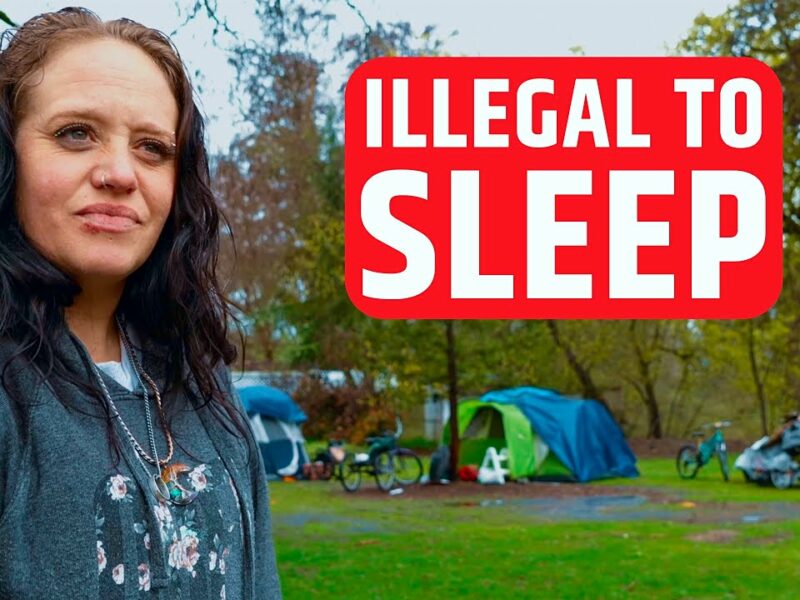How Sweeps Rarely Lead to Permanent Housing Situations for Homeless Encampment Residents
Homeless encampment “cleanups” have dirt on their name for good reason.
Alternatively referred to as “sweeps” or “homeless encampment evictions,” these forced relocations of our unhoused neighbors are marketed as a constructive way to reduce or even eliminate unsheltered homelessness.
The unsanitary truth is that, despite what is being sold to the public, homeless encampment cleanups rarely lead to permanent housing solutions. This is a recipe for failure of epic proportions and an expensive one at that. Here’s a look.
New Audit Proves Encampment Sweeps Aren’t Worth Their Salt: 95% of Encampment Residents Remain on the Streets When the Cleanup Crew Goes Home.
“Mayor Adams’ heavy-handed tactics are not the answer to homelessness,” proclaimed Cynthia Vee, a homeless New York City resident holding firmly to her tent and her mission. “I need a home,” she told reporters at NBC4.
Cynthia Vee is one of the dozens of homeless encampment residents currently dwelling in tents near East 9th Street and Avenue B in the East Village, a locale unofficially nicknamed “Anarchy Row.” Her encampment is slated to be cleaned up by the city, an action that will consist mainly of arrests, citations, and trashing whatever remaining belongings the residents still have in their possession.
Mainstream media touts that “homeless advocates” claim these forced relocations are ineffective and cruel. This is true, but it’s important to note that the data supports this assumption.
While Mayor Adams continues to campaign in favor of the criminalization of homelessness, serenading the cameras with a public performance Curbed Magazine contributor Robin Kaiser-Schatzlein aptly dubbed a “cruel theater,” the more than 250 encampment sweeps conducted have proved futile.
A recent New York City audit by Comptroller Brad Lander found that out of 2,308 encampment evictions, only three homeless residents received permanent housing. Furthermore, only 5% of evicted encampment residents were given temporary shelter.
That means 95% of all swept encampment residents were right back on the streets that very same night. The only difference was that they were now additionally burdened with legal fees and pending citations. Oh, and they lost all of their remaining belongings in the process.
Comptroller Brad Lander and Other Homeless Experts Urge the Utilization of Housing First
In response to the jaw-dropping results of his most recent audit, Comptroller Brad Lander urged politicians and lawmakers to revert their attention to Housing First strategies and to veer away from costly, ineffective undertakings like sweeps. Other homeless experts agree.
In an exclusive interview with Invisible People, Decriminalization Director for the National Homelessness Law Center Will Knight detailed the plight with the following statement:
“The purpose of sweeps is to make the homeless problem invisible. I think that’s because of our shared morality in seeing the suffering out there and subconsciously knowing that it’s not okay. I think that’s something we universally agree on.”
“Criminalization through encampment cleanups is a convenient way to put the homeless problem out of sight and out of mind for many people. This, in turn, makes it easier to pass harmful policies that further criminalize the homeless population,” Knight explained, adding that the tactic has a long and jagged history here in the US.
“We’ve been criminalizing homelessness for this entire country’s history, and we keep doing it. We keep proposing it, and it’s not helping. It’s never helped. You might compare it to what people say when you keep doing the same thing and expecting different results… Right? It’s insanity.”
“When all of the homeless people are living in jail cells, or they have been displaced because they’re afraid of violent criminalization policies, then politicians who lack actual data to support their theory can claim that they’ve solved homelessness in a particular area when really all they’ve done is cage the homeless people and displace them. The reality of it is that they’ve increased the problem.”
“All of the people who’ve been caged are going to be released. They’re going to be less capable of finding housing when they leave the prison system, and then there will be even more people living on the streets. These tactics simply shift the burden onto other municipalities rather than addressing the core issue, which is the availability of affordable housing.”
Andrew Aurand, the SVP of Research for the National Low Income Housing Coalition, echoed these sentiments, honing in on the additional hardships these encampment cleanups pose for the future.
“Forced removal from encampments – without first ensuring access to safe housing – is counterproductive, dehumanizing, and harmful,” said Andrew in a statement to Invisible People. “When individuals are not given the option to move into permanent housing, encampment ‘sweeps’ can put unhoused people at risk of additional trauma, exacerbate health conditions, disrupt relationships and continuity of care between service providers and encampment residents, and create additional barriers to accessing future housing.”
Tell Your Local Legislators to Endorse Housing First and Other Non-Punitive Approaches to Homelessness
These out-of-sight, out-of-mind tactics are not just ineffective. They also have real-life consequences for housed and unhoused communities alike.
Over-populating the prison system with non-violent offenders who cannot afford housing takes taxpayer dollars out of the community. It puts taxpayer dollars in the pockets of corrupt prison profiteers who are making a killing off the pain and suffering of our fellow human beings.
Spending hundreds of millions of dollars to enforce anti-homeless ordinances is another example of misusing taxpayer funds. This, in turn, places hardships on other community systems such as healthcare, welfare, and education.
The next time you turn on the television and witness one of these encampment cleanups, tell your friends and neighbors the sobering truth: more than 95% of the people you see on the screen will be right back on the street by nightfall.













